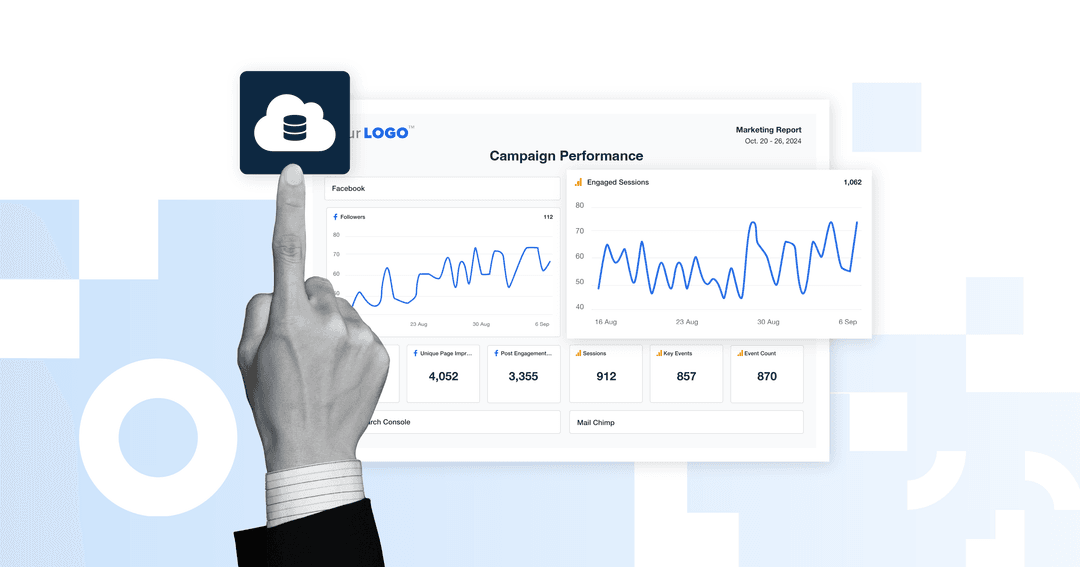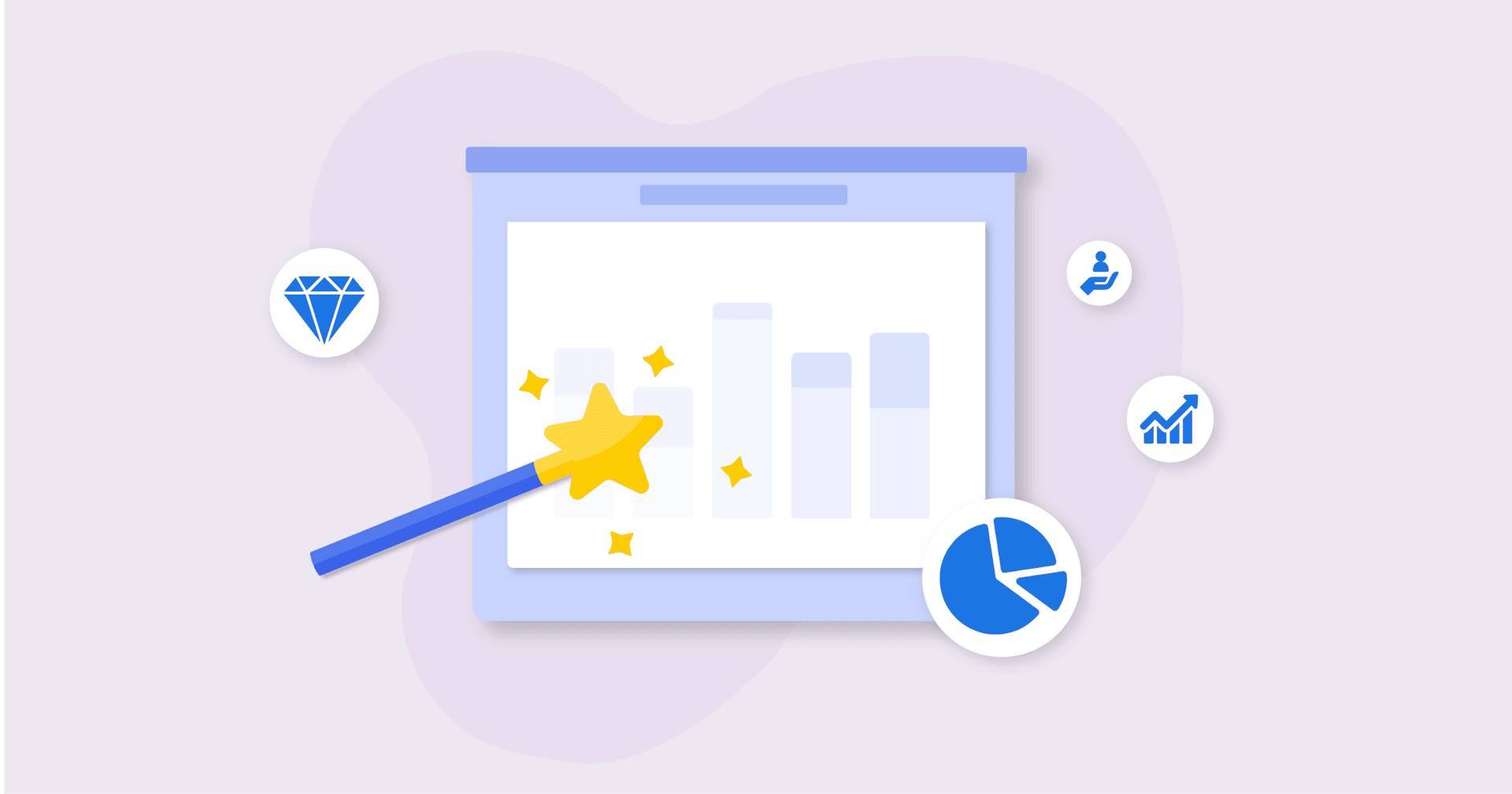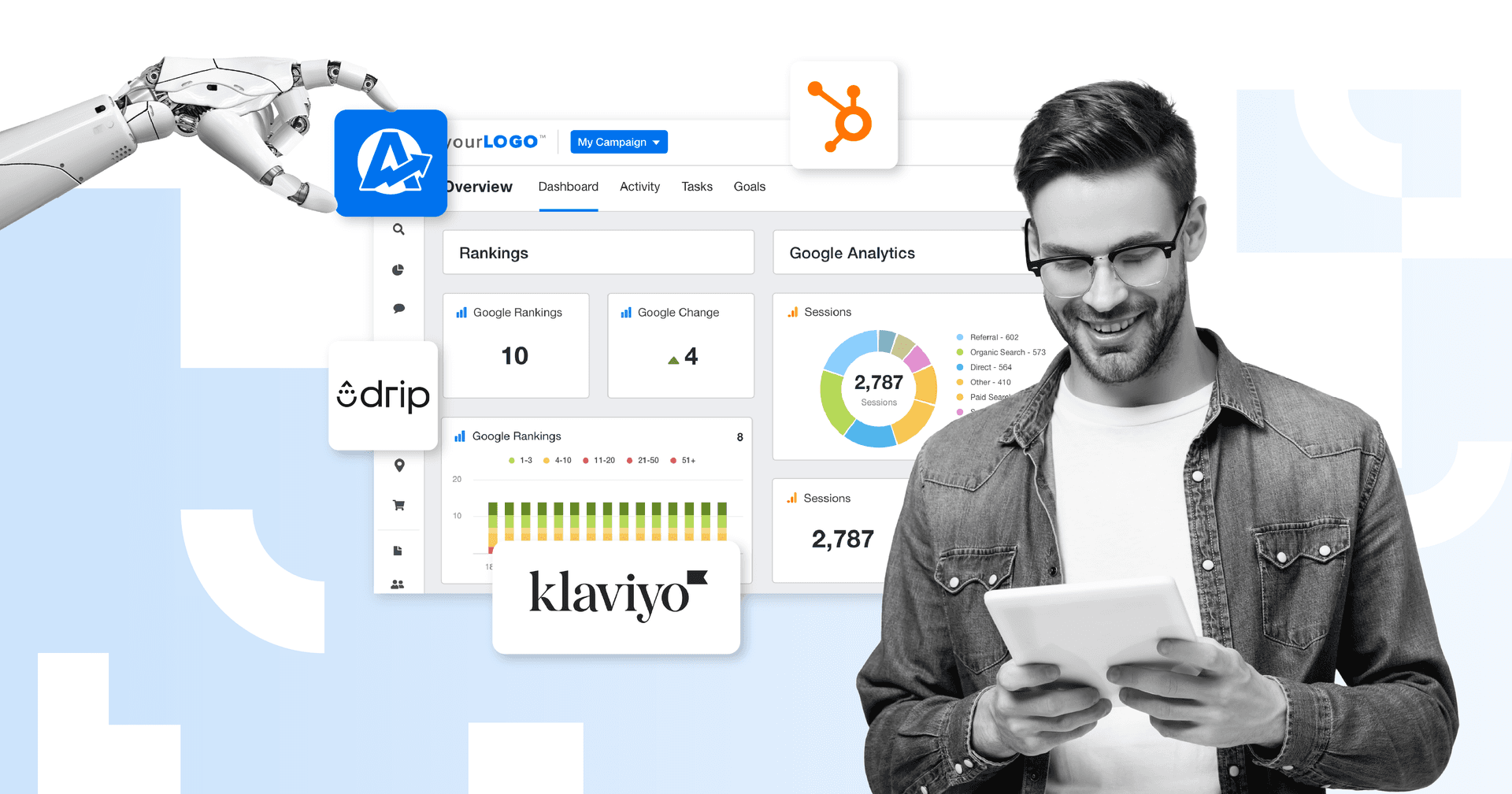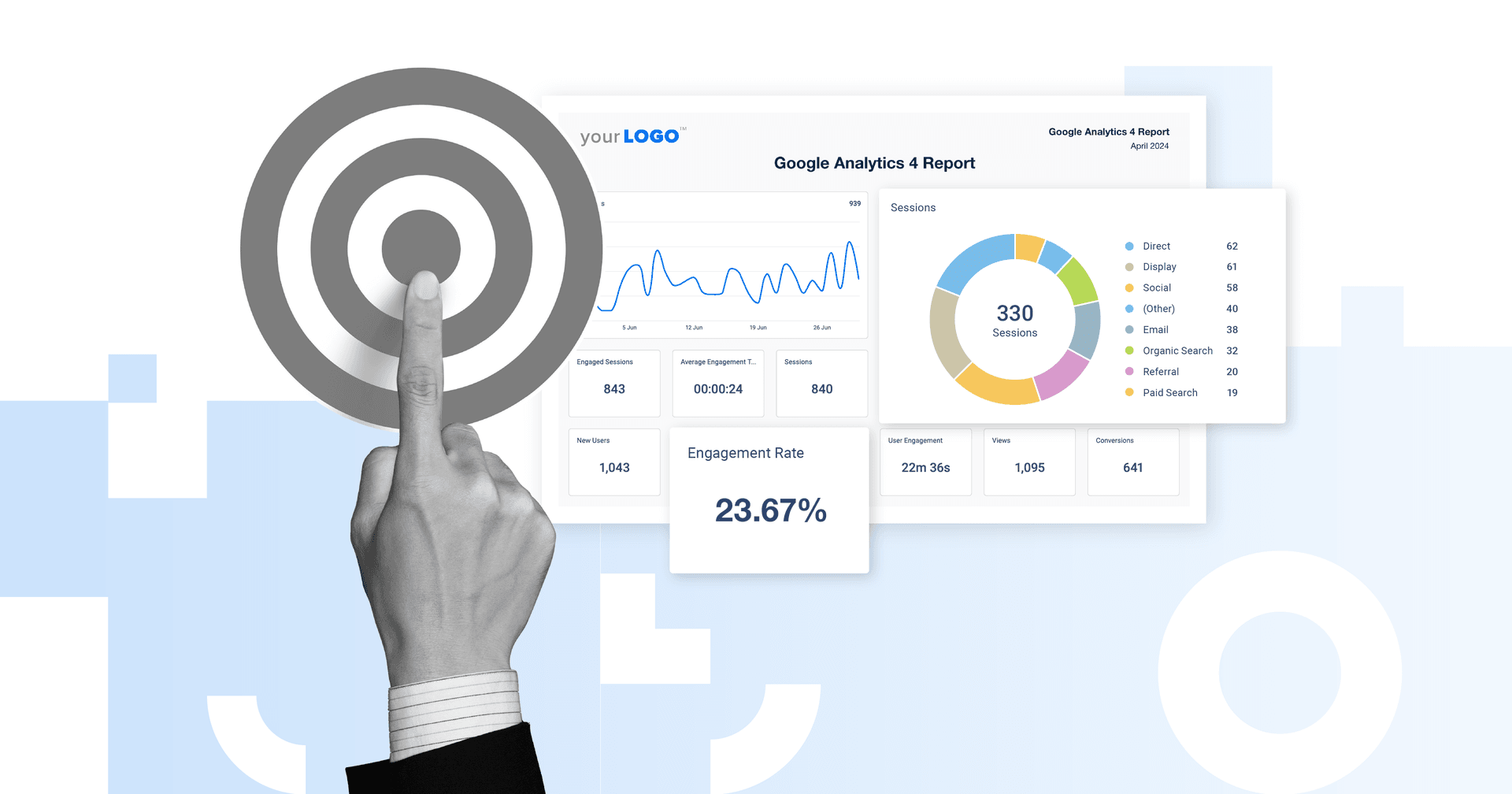Table of Contents
Table of Contents
- What is First-Party Data?
- Why First-Party Data Is Becoming Critically Important
- Zero-Party Data vs. First-Party Data
- First-Party Data vs. Second-Party Data vs. Third-Party Data
- Examples of First-Party Data
- How To Collect First-Party Data
- How To Use First-Party Data in Marketing and Advertising
- Building Your First-Party Data Strategy
- Alternatives To Third-Party Cookies
- Contextual Advertising: Getting Traditional in a Cookieless World
- Intuitive Solutions for Complex Data
- Welcome to the First-Party Data Party
7,000+ agencies have ditched manual reports. You can too.
Free 14-Day TrialQUICK SUMMARY:
First-party data is collected directly from users through their interactions with a company's digital channels. It offers accurate insights, enhances personalization, and ensures compliance with privacy laws. As third-party cookies phase out, leveraging first-party data is important for targeted marketing and maintaining customer trust. This article explains the benefits and strategies for using first-party data to prepare for the cookie-less future.
As the digital marketing world prepares to say goodbye to third-party cookies, it's critically important to have a strategy in place. What is the key to thriving in this new era? First-party data.
Understanding and leveraging first-party data gives your agency a competitive edge. Gathered directly from your interactions with clients, first-party data makes creating personalized marketing strategies more accurate and even more valuable. As third-party cookies fade out, your agency's ability to harness first-party data will determine how well you tailor and enhance client campaigns.
This guide will explain the nuances of first-party data, from ways to collect the data to its practical applications. You'll learn how to meet and exceed client expectations and ensure your agency remains a step ahead.
Ready to transform this industry challenge into a strategic advantage for your agency? Let’s dig in.
What is First-Party Data?
First-party data, often abbreviated as "1P data," is information collected directly from your clients' interactions with customers. This includes details gathered from behaviors observed on your clients' websites.
Why is this data so crucial? First-party data stands out because it’s accurate and cost-effective. It enables highly personalized marketing strategies that are sensitive to customer privacy. Best of all, it's completely owned by your agency or clients, giving you full control over its use.
Why First-Party Data Is Becoming Critically Important
Why is first-party data important? Well, if your agency isn’t helping clients collect and use first-party data, it’s already behind. Customers expect tailored marketing experiences, and third-party cookies are disappearing, leaving agencies with one clear solution: first-party data.
This data gathered directly from site visitors, email subscribers, and customer interactions is more accurate and compliant with data privacy laws like GDPR and CCPA. Unlike third-party data, which is often outdated or unreliable, first-party data is collected with explicit content and creates personalized experiences based on real customer behavior—not assumptions.
Beyond personalization, first-party data protects your clients from future privacy regulations. Google, Apple, and other major platforms are tightening restrictions on data tracking, making first-party data the safest and most sustainable path forward.
Today, agencies that implement first-party data strategies will deliver better results, outperform competitors, and build stronger client relationships.
The Benefits of First-Party Data
As the reliance on third-party cookies crumbles, first-party data is a must-have. Here’s why it’s essential:
More Personalized Marketing: First-party data refines audience targeting and tailors messaging based on actual customer behavior.
Greater Data Control: Your clients own their first-party data, eliminating reliance on external providers.
Stronger Compliance: First-party data is collected directly from customers with consent and aligns with data privacy laws.
Higher ROI: Agencies use first-party data to optimize ad targeting, increase engagement, and refine retargeting strategies—making marketing budgets work harder.
Better Customer Relationships: Transparent data collection and tailored experiences build brand trust and loyalty.
Embracing first-party data reshapes how you connect with your clients’ customers, making every interaction more relevant and your marketing efforts more effective.

Track, measure, and optimize your client campaigns with a custom performance dashboard. Get real-time insights and showcase results effortlessly. Try AgencyAnalytics for free today!
Zero-Party Data vs. First-Party Data
Understanding the nuances between zero-party and first-party data is key in today’s data-driven marketing scene. Here’s the lowdown:
Zero-party data is information customers willingly provide—like survey responses, preference settings, and product interests.
First-party data is based on observed customer interactions, such as website visits, email opens, purchase history, and behavioral trends. While it requires interpretation, it provides deeper insights into user behavior.
Using both zero-party and first-party data strengthens audience segmentation, improves engagement, and ensures compliance with data privacy laws.

First-Party Data vs. Second-Party Data vs. Third-Party Data
The table below shows some of the biggest differences between these types of data:
| Collected from customers directly | Customer consent | Individual data | Accurate and reliable | Data shared with other parties |
|---|---|---|---|---|---|
First-Party Data | ✅ | ✅ | ✅ | ✅ | ❌ |
Second-Party Data | ✅ | ✅ | ✅ | ✅ | ✅ |
Third-Party Data | ❌ | Depends | ❌ | ❌ | ✅ |
What Are The Differences Between Each Data Type?
The main difference between first-party and second-party data is who’s using the data at the end of the day. First-party and second-party data are similar, but the key difference is ownership—clients control their first-party data, while second-party data is shared or sold.
With first-party data, your clients collect it to use it themselves, whereas second-party data is collected by the company and sold to others. In other words, the minute your client decides to sell their first-party data to someone else, it becomes second-party data to whoever is buying it.
Third-party data, on the other hand, is collected across websites, apps, and different platforms by a third-party entity (such as marketers, advertisers, or social media platforms). That data is then combined into aggregate data (instead of individual data) to create detailed audience profiles before being sold to others.
Third-party cookies are the means by which your third-party data is collected and tracked across the internet.
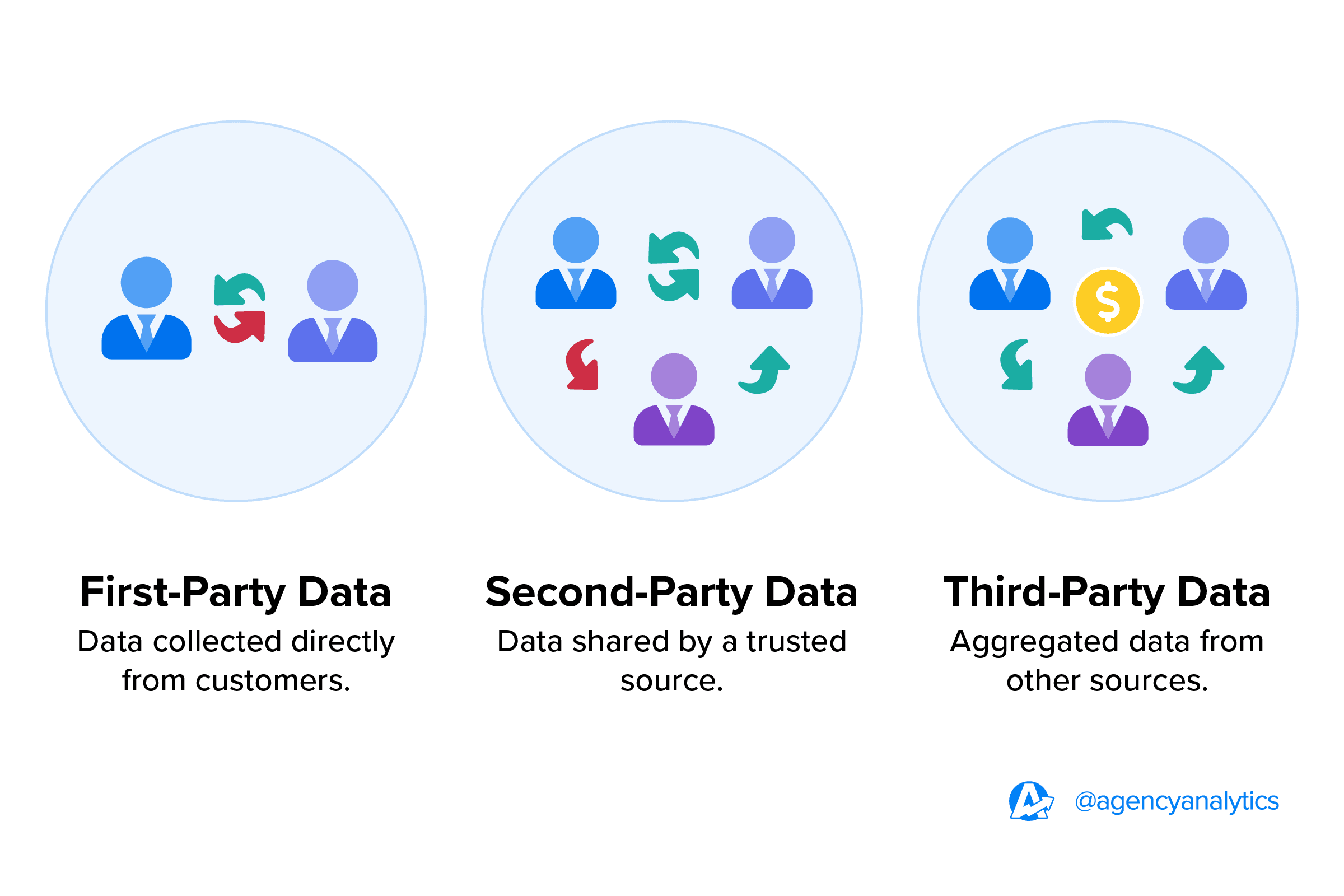
Examples of First-Party Data
First-party data is gathered directly from your clients' interactions with their customers across various touchpoints. This data is invaluable because it provides genuine insights into customer behavior and preferences.
Here are some key examples of first-party data:
Website analytics (site visitors, page views, session duration)
Customer purchase history (transactions, cart activity, repeat buyers)
Email engagement (opens, click-through rates, opt-ins)
Social media interactions (followers, comments, shares)
CRM data (customer profiles, support history, past inquiries)
Loyalty programs (point redemptions, repeat visits, membership growth)
Agency Advice: If you want to get even more granular, first-party data also includes things like timestamps, IP address, search history, language(s) spoken, and even message history.
How To Collect First-Party Data
Here are a few best practices when it comes to collecting first-party data:
1. Lead Generation Forms
Some may write off lead generation forms as the realm of B2B, real estate, and SaaS, but they’re wrong and potentially missing out on a goldmine of first-party data. At the bare minimum, lead generation forms collect pertinent first-party data like name and email address, but that’s not all.
Once you update your client’s mailing list, the people who filled out those forms will provide you with even more valuable data, such as CTR, open rate, conversion rate, etc.
Even better, lead generation forms are easy to create and automate. The trick is to provide enough value to entice them to fill out the form. A few great ways to do that include:
Hosting a contest or giveaway
Providing something for free in exchange for information (like an eBook, newsletter, webinar, or downloadable template)
2. Surveys, Polls, and Quizzes
Surveys, polls, and quizzes are excellent ways to capture first-party data. They’re also great opportunities for agencies to get creative because you’ve got room to make them much more engaging than a simple lead gen form.
For example, do you remember how much fun those Buzzfeed quizzes used to be? The ones that had those click-bait titles like “Which Disney Princess Are You?” Not only were they fun to fill out and extremely shareable, but can you imagine the wealth of valuable first-party data Buzzfeed got from them? It’s kind of mind-blowing when you think about it.
Even in this era of increasing privacy concerns, people are more than willing to share their data if you make it fun for them to do so. It’s up to marketers and agencies to make it worth their while.
3. Customer Feedback and Reviews
We all tend to view customer reviews as more trustworthy than anything a company or salesperson might tell you. Not only is reading reviews a big part of the purchasing process, but they’re also a great source of first-party data.
For all these reasons, companies will go out of their way to ask their customers to give feedback and reviews, and we highly suggest that your agency does, too.
These reviews will also provide a wealth of first-party data, including how customers used the product or service, what they liked or disliked, etc.
How To Use First-Party Data in Marketing and Advertising
First-party data is one of the most valuable assets for measuring the effectiveness of client campaigns. It provides accurate customer profiles, tracks the customer journey, and helps refine audience insights in a way that third-party data providers simply can’t match. Here’s how to put it to work:
Track Engagement Metrics From Website Visitors
Analyze behavioral data from site visitors to understand how users interact with your client’s content. Metrics like page views, time spent on site, and bounce rates provide valuable insights into what’s working and where to optimize.
Measure Conversion Rates and Customer Purchase History
Campaign success ultimately comes down to revenue and conversions. Tracking historical data on purchases helps connect marketing efforts to actual sales. Look at trends in first-party customer data to see which campaigns drive action.
Analyze Email Engagement
First-party data from email campaigns, such as open rates and click-through rates, reveals how well your messaging connects with the target audience. Compare engagement between different segments and use predictive analytics to optimize future campaigns.
Assess Social Media Engagement From Followers
Social media platforms provide another source of first-party audience data. Track comments, shares, and interactions from social media followers to measure engagement levels. Insights from direct interactions help refine messaging and improve campaign performance.
Leverage Loyalty Program Data
If your client runs a loyalty program, monitor how campaigns impact customer retention. Look for increased point redemptions or program sign-ups to flag campaign success. First-party data monetization opportunities arise when agencies use loyalty insights to create personalized experiences.
Use CRM Data for First-Party Data Analysis
A well-managed customer relationship management (CRM) system contains first-party data sources that help assess a campaign’s impact. Look at changes in lead quality, customer inquiries, and retention rates to gauge long-term success.
Evaluate Data Quality and Accuracy
Campaign success depends on data accuracy. First-party data is more reliable than audience third-party data because it comes from a direct relationship between the company and its customers.
Segment and Target More Effectively
First-party data enables precise audience segmentation, improving first-party data targeting. Agencies should test different messaging and advertiser first-party data to refine strategies. Running A/B tests on a first-party data programmatic marketing strategy will help fine-tune your efforts.
Activating first-party data gives agencies a precise view of what’s driving client success. Agencies create more effective and measurable campaigns by collecting data directly from users, ensuring compliance with privacy laws, and integrating insights into their marketing strategies.
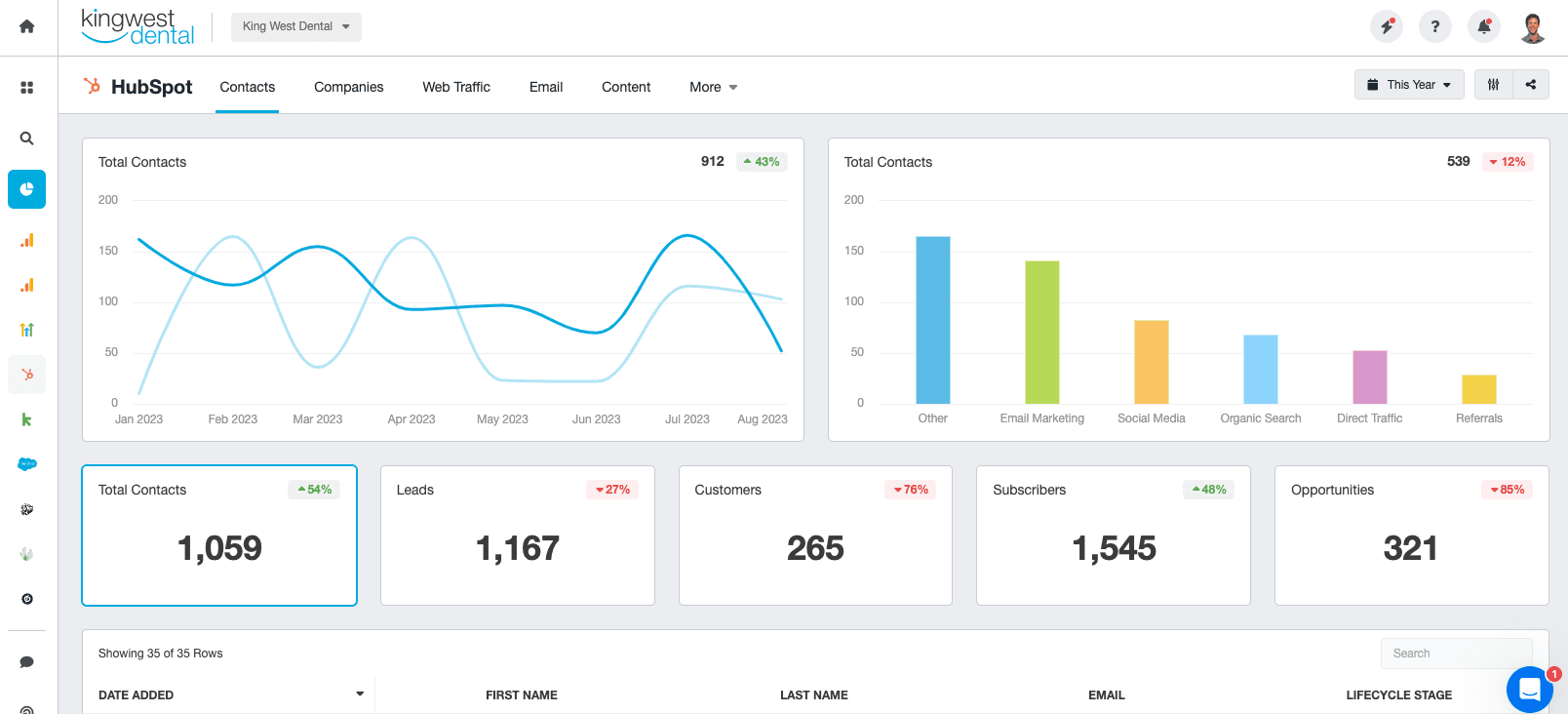
Turn your CRM data into actionable insights with AgencyAnalytics. Connect, analyze, and automate your reporting—all in one platform. Start your free trial today!
Building Your First-Party Data Strategy
A solid first-party data strategy helps agencies maximize the value of the data they collect while ensuring compliance with data privacy laws. The right approach strengthens customer relationships, improves targeting, and enhances marketing campaigns with valuable insights.
Here’s how to build a strategy that works:
1. Define Your Data Goals
Start by identifying what you want to achieve with first-party data collection. Are you optimizing audience insights, improving customer journey mapping, or enhancing predictive analytics for clients? Setting clear objectives helps determine what data points to focus on and how to structure your data analysis.
2. Identify Your First-Party Data Sources
First-party data comes from multiple touchpoints. Make sure your client collects information from:
Website visitors (page views, form fills, session duration)
Customer purchase history (transactions, cart activity, repeat purchases)
Social media followers (engagement metrics, ad interactions)
Email interactions (open rates, click-through rates, opt-ins)
Loyalty programs (sign-ups, redemptions, activity levels)
Customer service interactions (support requests, chatbot engagements)
A customer data platform (CDP) will help centralize this information, making it easier to analyze and use effectively.

3. Ensure Data Compliance and Consent
Data privacy is non-negotiable. Ensure your strategy follows GDPR, CCPA, and other regulations by obtaining explicit consent before collecting customer data. Make it clear how data sharing works and ensure transparency in how you collect and store information.
4. Integrate First-Party Data Across Channels
Integrate data with your client’s CRM, email marketing platform, and advertising tools to create accurate customer profiles and refine first-party data targeting. Connecting the dots between different data sources will boost your agency-client relationship.
5. Use Data To Personalize Customer Experiences
Leverage first-party audience data to create highly relevant, personalized experiences. Segment audiences based on their behavioral data, interests, and purchase history. Use this data to:
Serve tailored ads that align with past interactions.
Optimize email campaigns with dynamic content.
Improve website experiences by delivering content that matches user behavior.
Strengthen retargeting efforts using first-party data instead of third-party data.
6. Measure and Optimize Your Data Strategy
Your first-party data strategy isn’t static. Continuously analyze data quality and refine your approach. Track which data sources provide the most actionable insights and identify areas for improvement. First-party data monetization opportunities emerge when agencies find new ways to apply this data for better targeting and engagement.
Building a strong first-party data strategy ensures your agency delivers more effective marketing campaigns while staying ahead in a privacy-first world. Leveraging data responsibly and strategically enhances customer trust, improves marketing performance, and future-proofs your agency against industry shifts.

Bring all your clients’ first-party data under one roof by combining Google Analytics with over 80 other marketing platforms. Start your free 14-day trial today.
Alternatives To Third-Party Cookies
With Google set to kill third-party cookies in the near future (also known as “cookie deprecation”), “41% of marketers believe their biggest challenge will be their inability to track the right data,” according to Hubspot.
But that doesn’t mean agencies should start from scratch or rewrite the playbook. While some areas of marketing and advertising will be hit harder than others, here are a few exciting alternatives to third-party cookies that are already stepping up to help agencies prepare for a world without third-party cookies.
First-Party Cookies
It’s important to know that Google only plans to phase out third-party cookies. First-party cookies, which collect the first-party data we’ve been talking about, are completely safe for now.
This is a good thing because first-party cookies improve the user experience in many ways by remembering:
Login details
User preferences
Items in your shopping cart
With cookie deprecation set for next year, it’s more important than ever for agencies to be able to integrate that first-party data collected across dozens of marketing channels. Using a campaign dashboard template makes it remarkably easy for agencies to communicate complex data to their clients in a simple, visual way.
The Privacy Sandbox
According to Google, the Privacy Sandbox is “a new initiative to develop a set of open standards to fundamentally enhance privacy on the web.” Using this set of tools, agencies will still be able to target ads to specific audiences, even with fewer user data.
For example, in a recent blog post, Google announced a new Privacy Sandbox proposal called “Topics,” an API created with interest-based advertising in mind. In a nutshell, browsers would determine a user’s top interests based on search history and then organize these interests into topics like “Fitness” or “Travel and Transportation.” When visiting a site, only three Topics will be shared with the site and advertising partners.
To protect privacy, these Topics are only stored for three weeks before being deleted and are selected on the device only, meaning no external servers can access them, not even Google.
The Topics API is a new proposal replacing a previous idea known as FLoC (Federated Learning of Cohorts) that was meant to identify and group users based on cohort.
Contextual Advertising: Getting Traditional in a Cookieless World
Times of rapid change and uncertainty often produce the most innovative solutions, and just as the deprecation of third-party cookies presents many challenges, it presents just as many opportunities.
In fact, there’s no better time to look back at some of the tried-and-true marketing strategies from the ads and commercials of yesteryear. Marketers and agencies have always been able to reach their audiences differently. One of the most effective of them was Contextual Advertising.
It’s All About Context
We’ve been discussing behavioral advertising, which uses the data collected from cookies to send targeted ads based on user behavior.
On the other hand, contextual advertising targets ads based on a website’s content and context.
Examples of Contextual Advertising include:
Headphone ads appearing on a music blog
An ad for helmets appearing on a cycling video
A toolbelt ad appearing on a forum for carpenters
Intuitive Solutions for Complex Data
It’s imperative for agencies to harness the power of first-party data to customize the customer experience. Ultimately, marketing agencies should have a stronger hold on the metrics than ever.
The more complex the data, the better agencies need to communicate their clients’ campaign data in a way they’ll understand. Client reporting tools such as the AgencyAnalytics campaign dashboard template were built to empower agencies and make reporting and data storytelling a breeze.
Many dream about simple marketing agency reports, dashboards, templates, and automated reporting with all integrations, and AgencyAnalytics has made that a reality with our intuitive white label analytics dashboards.
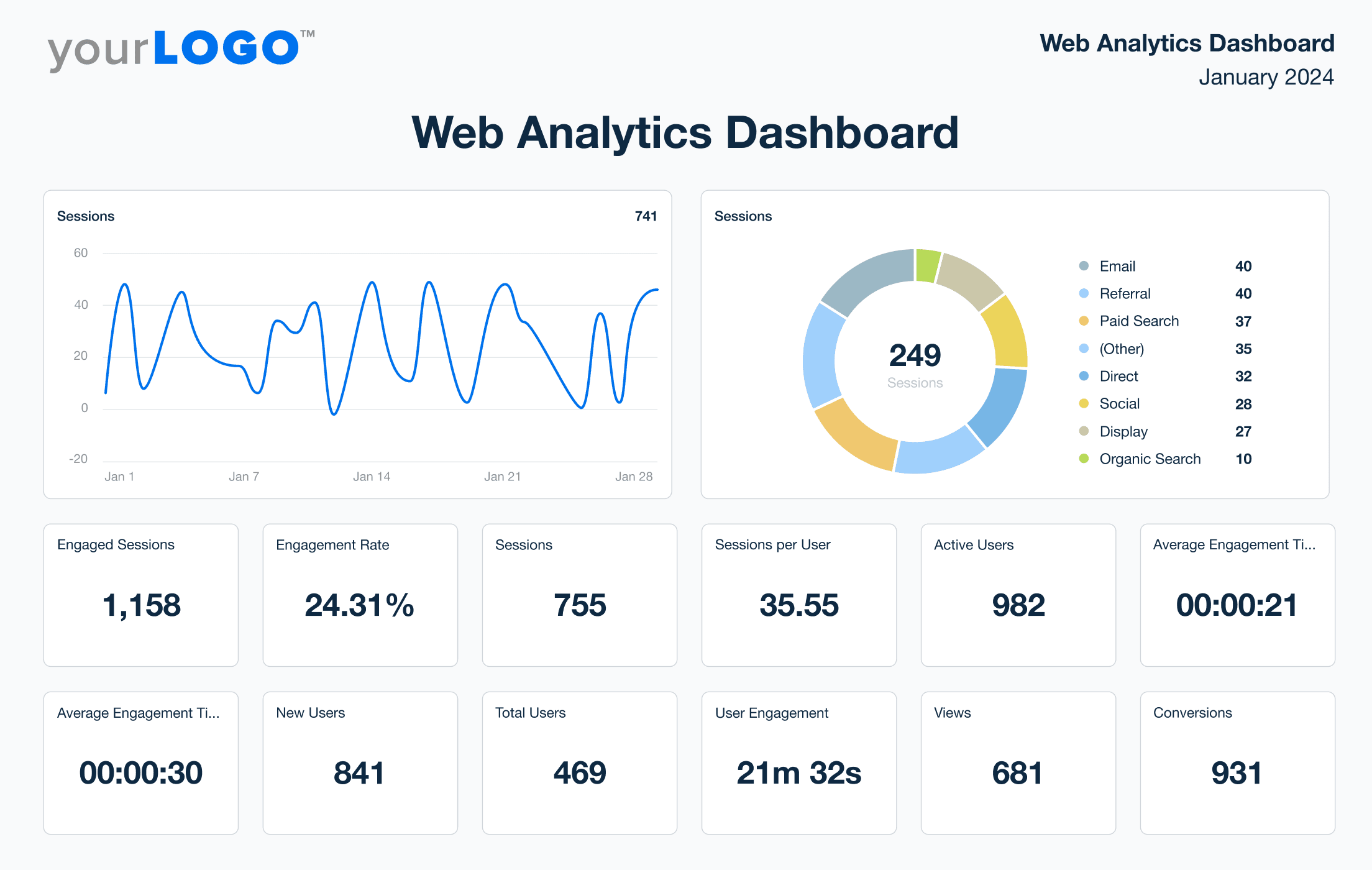
Collect all your clients’ campaign data under one roof with AgencyAnalytics. Get your campaign dashboard template set up in minutes with a free 14-day trial.
Welcome to the First-Party Data Party
As we prepare for cookie deprecation, agencies need to consider different ways to compensate for that change.
First-party data is the most valuable type of data because it is free, unique, and comes directly from the customers themselves. Plus, it’s owned by your clients.
Agencies should start prioritizing the collection of first-party data now. A few easy ways to do that are through lead generation forms, surveys, quizzes, and incentivizing customer reviews.
So, prepare to impress your clients with the information covered in this article as you confidently answer any questions your clients have about the death of third-party cookies. With the help of AgencyAnalytics campaign dashboards, show them you mean business with powerful insights that will completely blow them away and make them happy that they signed with you.
Start leveraging first-party data today. Use AgencyAnalytics to track key metrics, refine targeting, and deliver data-driven results that impress clients. Try it free for 14 days.

Written by
Francois Marchand brings more than 20 years of experience in marketing, journalism, and content production. His goal is to equip agency leaders with innovative strategies and actionable advice to succeed in digital marketing, SaaS, and ecommerce.
Read more posts by Francois MarchandSee how 7,000+ marketing agencies help clients win
Free 14-day trial. No credit card required.



